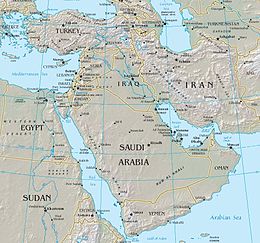 | |
| Area | 7,207,575 km2 (2,782,860 sq mi) |
|---|---|
| Population | |
| Countries | UN members (16) UN observer (1) |
| Dependencies | |
| Languages | 60 languages
|
| Time zones | UTC+02:00, UTC+03:00, UTC+03:30, UTC+04:00 |
| Largest cities | |


The Middle East (term originally coined in English [see § Terminology][note 1]) is a geopolitical region encompassing the Arabian Peninsula, the Levant, Turkey, Egypt, Iran, and Iraq.
The term came into widespread usage by the United Kingdom and western European nations in the early 20th century as a replacement of the term Near East (both were in contrast to the Far East). The term "Middle East" has led to some confusion over its changing definitions.[2] Since the late 20th century, it has been criticized as being too Eurocentric.[3] The region includes the vast majority of the territories included in the closely associated definition of West Asia, but without the South Caucasus. It also includes all of Egypt (not just the Sinai) and all of Turkey (including East Thrace).
Most Middle Eastern countries (13 out of 18) are part of the Arab world. The most populous countries in the region are Egypt, Turkey, and Iran, while Saudi Arabia is the largest Middle Eastern country by area. The history of the Middle East dates back to ancient times, and it was long considered the "cradle of civilization". The geopolitical importance of the region has been recognized and competed for during millennia.[4][5][6] The Abrahamic religions, Judaism, Christianity, and Islam, have their origins in the Middle East.[7] Arabs constitute the main ethnic group in the region,[8] followed by Turks, Persians, Kurds, Azeris, Copts, Jews, Assyrians, Iraqi Turkmen, Yazidis, and Greek Cypriots.
The Middle East generally has a hot, arid climate, especially in the Arabian and Egyptian regions. Several major rivers provide irrigation to support agriculture in limited areas here, such as the Nile Delta in Egypt, the Tigris and Euphrates watersheds of Mesopotamia, and the basin of the Jordan River that spans most of the Levant. These regions are collectively known as the Fertile Crescent, and comprise the core of what historians had long referred to as the cradle of civilization (multiple regions of the world have since been classified as also having developed independent, original civilizations).
Conversely, the Levantine coast and most of Turkey have relatively temperate climates typical of the Mediterranean, with dry summers and cool, wet winters. Most of the countries that border the Persian Gulf have vast reserves of petroleum. Monarchs of the Arabian Peninsula in particular have benefitted economically from petroleum exports. Because of the arid climate and dependence on the fossil fuel industry, the Middle East is both a major contributor to climate change and a region that is expected to be severely adversely affected by it.
Other concepts of the region exist, including the broader Middle East and North Africa (MENA), which includes states of the Maghreb and the Sudan. The term the "Greater Middle East" also includes parts of East Africa, Mauritania, Afghanistan, Pakistan, and sometimes the South Caucasus and Central Asia.
- ^ "The Middle East Population". 2024. Retrieved 2024-10-09.
- ^ Cite error: The named reference
dontwas invoked but never defined (see the help page). - ^ Cite error: The named reference
hanafiwas invoked but never defined (see the help page). - ^ Cairo, Michael F. The Gulf: The Bush Presidencies and the Middle East Archived 22 December 2015 at the Wayback Machine University Press of Kentucky, 2012 ISBN 978-0-8131-3672-1 p. xi.
- ^ Government Printing Office. History of the Office of the Secretary of Defense: The formative years, 1947–1950 Archived 22 December 2015 at the Wayback Machine ISBN 978-0-16-087640-0 p. 177
- ^ Kahana, Ephraim. Suwaed, Muhammad. Historical Dictionary of Middle Eastern Intelligence Archived 23 December 2015 at the Wayback Machine Scarecrow Press, 13 April 2009 ISBN 978-0-8108-6302-6 p. xxxi.
- ^ MacQueen, Benjamin (2013). An Introduction to Middle East Politics: Continuity, Change, Conflict and Co-operation. SAGE. p. 5. ISBN 978-1446289761.
The Middle East is the cradle of the three monotheistic faiths of Judaism, Christianity and Islam.
- ^ Shoup, John A. (2011). Ethnic Groups of Africa and the Middle East: An Encyclopedia. Abc-Clio. ISBN 978-1-59884-362-0. Archived from the original on 24 April 2016. Retrieved 26 May 2014.
Cite error: There are <ref group=note> tags on this page, but the references will not show without a {{reflist|group=note}} template (see the help page).